6 Nerdy Cool Things We Saw at the Tribeca Film Festival
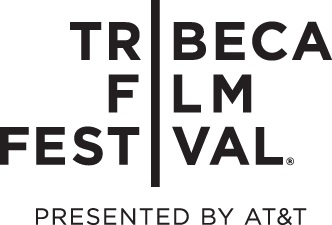 |
| Tribeca Film Festival |
Founded in 2002 because Robert De Niro hated flying to France (Editor’s note: That is not even remotely close to true – it was founded in response to the expanding film and TV presence in NYC and as a post-9/11 jolt to the lower Manhattan economy, but good try), the Tribeca Film Festival almost immediately became one of the premier festivals in the world. This year alone, the festival saw nearly 500,000 people attending one of its almost 500 events in downtown Manhattan – mind boggling numbers even for the largest city in the country. In addition to its size, TFF is also a great place for genre films, a nurturing home to some pretty obscure, nerdy stuff. Here are 6 of the coolest things we saw there.
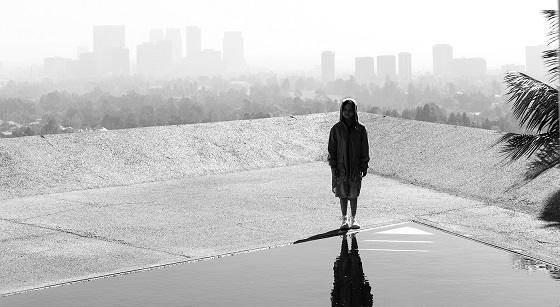 |
| Tribeca Film Festival |
Future Relic 03 is, surprise, the third in a series of futuristic shorts from Daniel Arsham showing a post-apocalyptic world following some kind of vague ecological collapse. Each short centers around a particular object or artifact, and tells the story of the collapse in a roundabout way through that object. The prior one debuted in October, and had James Franco locked in a clean room, digging through ash and glass following the whatever it was that happened. This one, which debuted at Tribeca, has Juliette Lewis and a lot more hints about the overall story Arsham is trying to tell.
It creeps right up to the line of self-indulgent artsy bullshit, but it never really crosses it, and piecing together this short with the other two that are out there, you start to get an idea of the edges of the world Arsham is building. Lewis’s character’s father was apparently instrumental in discovering the imminent collapse, and she’s continuing his research on non-Newtonian fluids. The story isn’t really the draw here, though.
Arsham is apparently (by his own press materials) very interested in architecture, and that much is evident by the locations he chose to shoot and the way he shot them. With the exception of a couple of wonky effects shots meant to show a mine on the Moon, every frame of this short was stunning. I would maim up to 3 people (one of them a relative, if necessary) just to spend a week in the LA house that the flashbacks are shot in, and he used LA’s smog as a visual effect all its own. The lab building where most of the short takes place is impressive – immense and intimidating, but made to feel intimate through Lewis’s conversation with her dead father’s statue. Once all 9 of these shorts are released, I’d be very interested in watching them straight through. Maybe then I can finally get closure about why there’s a donkey just chilling on the third floor of this lab.
2. Far From Men
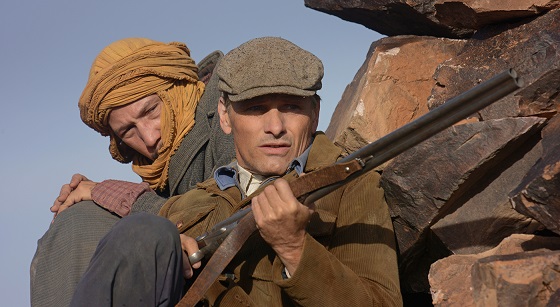 |
| Tribeca Film Festival |
Viggo Mortensen is one of those actors who’s interesting in whatever he does. Whether it’s crushing your soul in The Road, going full Eddie Dean in a bathhouse in Eastern Promises, banging Maria Bello’s back out on a staircase in A History of Violence or teaching a bunch of Algerian kids how to say “The Rhine” in Elvish, he’s just completely magnetic. Far From Men is the story of Daru, a former Major in the French army in World War 2 who now teaches a bunch of local kids in Algeria while their war for independence from France erupts around them. He’s brought a man accused of killing his cousin and asked to take him to the next town over by an old army buddy, and the movie follows the two of them as they pick through the desert countryside and the blossoming revolution.
This is a really good movie. I know it’s not specifically nerdy, but I figure Mortensen’s earned enough nerd cred that people tend to be on the lookout for movies he’s in as a rule – I know that’s the only reason I saw Appaloosa. He’s a really unique talent, too. I’m conversational in a couple of languages, and let me tell you, lying in a tongue that’s not your own is REALLY difficult. Mortensen acts, and acts convincingly and comfortably, in three languages here, and none of them are English. The ability to transition smoothly from French to Arabic to Spanish and never miss a beat is a credit to the production crew, who I’m sure helped him through this, but also to his talents as an actor and a polyglot. The attention to detail was outstanding – after Daru and Mohamed were caught in a rainstorm, the grime on Mortensen’s face was so caked on that I wanted to go splash water on myself because I felt dirty. In my defense, I sweat a bunch, so I probably was, but still. Good movie.
3. Bodyslam: Revenge of the Banana
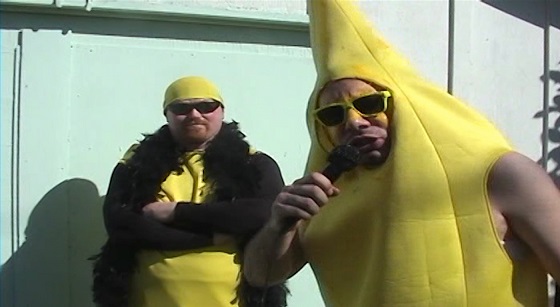 |
| Tribeca Film Festival |
I know very little about rasslin. There were, like, 2 good years where I was an active WWE fan – around the MSG Royal Rumble, with the TLC match between Edge and Christian and the Dudley and Hardy Boyz (which was soooooooooooooooooo good). But other than that, I’m pretty much entirely disengaged from pro-wrestling fandom. That’s still enough for me to recognize two fundamental truths about the sport: wrestling love is like any other subculture, in that it’s a way for people to use fiction to connect with a community and relate to the world around them; and wrestling crowds are the best.
Bodyslam: Revenge of the Banana is at its best when it focuses on the sports entertainment angle of SSP, the Seattle semi-pro wrestling league that was the core of this documentary. It followed a handful of outcasts, folks who have had an admittedly tough time fitting in, who found themselves when they were pretending to beat the hell out of each other in front of a roadhouse-rowdy crowd pelting them with empty PBR cans. Honestly, through the first half of the movie, it felt like a better, more meaningful version of Bronies. The trick with documentaries is how you phrase the answer to “Why are you telling this story?” Bronies failed in that the filmmakers (and the subjects in some cases) were almost defensive about it – their answer was “to help people understand us so they’ll leave us alone.” The first half of Bodyslam seemed to answer that question with “Because we love wrestling, we love the SSP, and we want to share our love with people.”
Then the whole movie pivots.
Paul, the titular Banana, is a pretty stubborn guy who didn’t care for the character the rest of SSP had written for him. And instead of being flexible about it, instead of working with him to try and make a character he enjoyed, the SSP writers just tried to box him out. In a move that was surprising to nobody who watched the first 45 minutes of the story, Paul decided to narc them out to the state of Washington, getting SSP embroiled in a legal pissing contest with state regulators and eventually leading to a temporary shutdown of the league.
This story unfolds with all the excitement and drama you’d expect from an after-the-fact accounting of an Internet flame war, with an added layer of libertarian self-delusion as the wrestlers bemoan the unnecessary government regulation that requires safety training and insurance before they smash their heads into a stage while they get half-full beers hucked at them. To be fair to the filmmakers, they were probably on the same page as me here. You don’t put voiceover of someone trying to semantically convince themselves that “no wrestling [was]going on” over video of wrestling going on unless you’re trying to be sarcastic.
The last 20 minutes of the movie turns again, from a riveting investigation of who posted that thing in the comments section of The Stranger to “Mr. McFondle Goes to Washington [state capital Olympia]” as the wrestlers take their case to the state to get the league reinstated. I really wish the whole movie had the energy of the first half, but once SSP’s story devolved into a dick-measuring contest, it stopped being interesting.
4. Angry Sky
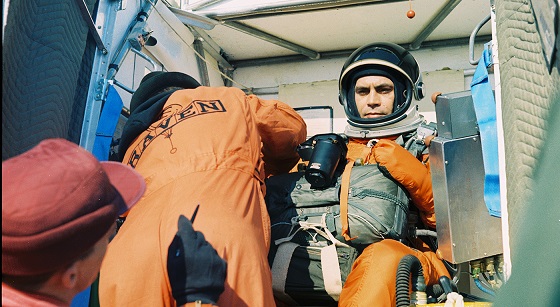 |
| Tribeca Film Festival |
A couple of years ago, Felix Baumgartner set the freefall record, jumping out of a gondola attached to a weather balloon from 24 miles above the earth and skydiving down. Angry Sky, a 30 for 30 documentary from ESPN Films, is about the guy who held one of the records Baumgartner broke: Nick Piantanida, a renaissance man (sort of) from New Jersey with no impulse control whatsoever.
Piantanida had no clue what he was doing when he started out. We’re shown, through an interview with his brother, how Nick was fond of tossing himself off of buildings with inadequate parachutes, and that his chronic aversion to authority and conformity led him to actually turn down a contract with the Knicks because he gave insufficient shits to actually commit to the sport. He was the first to scale the north face of Angel Falls in Venezuela after becoming obsessed with it in the Army, and he was so woefully underprepared for the climb that it’s a miracle he didn’t kill himself there. After that brief introduction, the movie follows him to south Jersey, where he starts parachuting regularly and hatches his scheme to set the world record for the highest skydive ever.
His plan was a combination of epic bullshittery and cold war paranoia: he convinced the federal government to contribute to his efforts because the Soviets were the then-current world record holders, and he ended up contributing a significant body of research and knowledge to pressure suit and weather balloon construction. He also treated the whole project like a backyard hootenanny, and that’s what proved to be the most difficult obstacle. Spoilers: he dead.
These 30 for 30 documentaries are outstanding, and it took a lot of self restraint on my part not to write them all up. I will say the guy who played Humbert Humbert in Down in the Valley was a pretty crap actor, but otherwise, I’ve lost hours to the most random subjects – what an asshole Jimmy Connors is; why my passionate, irrational hatred of Duke basketball is actually totally justified and correct – in this documentary series, and Angry Sky, despite being a little more about the hard sciences, is no different. They’re all worth seeing.
5. Jackrabbit
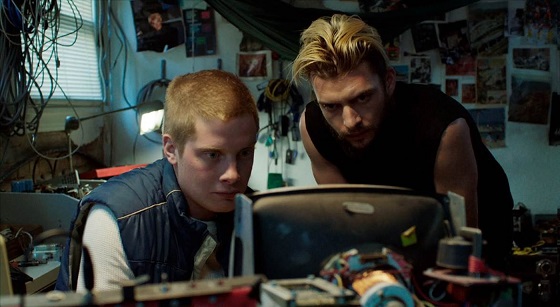 |
| Tribeca Film Festival |
Jackrabbit is about a vaguely totalitarian dystopia, a city where all its inhabitants are under constant surveillance by its governing body. After an ecological/electronic catastrophe referred to as “The Reset,” all technology more complicated than mid-80s Apple 2s ceased to function. The movie works as a commentary on a lot of things – a neo-Luddite criticism of our reliance on technology and of how easily we accepted being rolled into a surveillance state, most notably – but the best part of Jackrabbit is that, social relevance aside, it’s a pretty damn entertaining movie.
The plot is somewhat straightforward: Eric is a mid-level operative in Vopo Technologies, the corporation that owns the city where the movie takes place, when he kills himself. He leaves a file on a drive for his friends Max (a troublemaking hacker) and Simon (Eric’s eventual replacement at Vopo) to figure out what’s in the file. The two of them pick their way through their surveillance state, eventually discovering the extent of Vopo’s badness. The movie is well acted – there’s a scene between Simon, Max and Grace, a nurse who the two run into in the course of their investigation, that reveals some of Max’s background and gives you a look into how shitty their world is that’s sold very well by all the actors involved. Joslyn Jensen, the actress who plays Grace, has a limited role but a huge impact on the movie, and she does a fantastic job with her role.
Jackrabbit’s world is a cyberpunk retrofuture. Technology is sparse, reclaimed and very valuable, and the filmmakers do a good job of making everything match that. Everything looks shabby and re-re-recycled to the edge of breaking, helping bring the viewer right into the movie’s universe. It’s like what we expected the world to look like in 30 years if it were still 1985 and we were reading Neuromancer with D.A.R.Y.L. on in the background, right down to the hideous prints on polo shirts. It felt…too real.
6. Tomorrowland
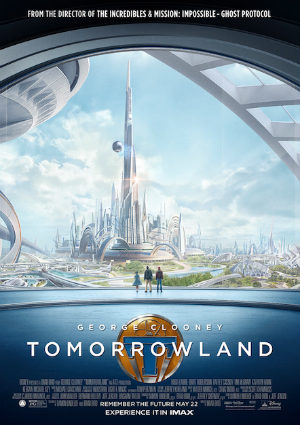 |
No, Tomorrowland didn’t premiere at Tribeca this year. However, as part of their “Tribeca Talks” series, Brad Bird and Janeane Garofalo chatted about his career, his methods and operating theory, and in the process snuck in a pretty boss preview of the mysterious movie-based-on-a-section-of-Magic-Kingdom coming out at the end of May.
The preview clip they showed opens on a young John Francis Walker walking into the 1964 World’s Fair in Queens, heading for the Inventor’s Pavilion with a giant sack on his back. Hugh Laurie, sitting at the desk, asks him what’s in the bag, and the kid opens it to show his sick jetpack. After some back and forth about the functionality of said jetpack (it flies, but mostly in a straight line, very fast and about an inch below ground level), Laurie tries to send Walker away. Walker argues that it’s valuable because it’s fun, and it would inspire people. He is unfortunately prevented from entering his semi-functioning jetpack in the exhibition. While he’s dejectedly sitting outside the pavilion, Athena, a mysterious young girl who’s affiliated somehow with Laurie, comes out, tells him to follow her and hands him the button from the trailer that transports whoever touches it to a happy parallel world. Walker eventually grows up to be a George Clooney, and I can only assume everyone lives sexily ever after.
Bird’s a pretty interesting guy. His career trajectory, from The Simpsons through The Iron Giant and his Pixar movies and into giant franchise territory with Mission Impossible: Ghost Protocol, places him as a through-line to the mainstreaming of nerd culture. He’s also responsible for some of the most hopeful, optimistic science fiction that’s come out in recent memory, and the clip of Tomorrowland and his own words at Tribeca make it clear that this is a conscious choice. Optimism, he says, gets a filmmaker “dismissed as naive.” There are a lot of different causes, but so much of today’s genre fiction in any medium is apocalyptic, oppressive, depressing, gloomy reflections of our existence, and it’s refreshing to hear a big name actively pushing back against this. Based off of the preview footage, I’m really excited to see Tomorrowland. But it’s what Bird seems to want to say with it that makes me a guaranteed opening-weekend buy for it.
Previously by Jim Dandeneau
10 Important Clues to the Conclusion of Multiversity
The 9 Worst, Most Exploitative Nerdy Crowdfunding Campaigns
11 Valiant Comics We Want To See On The Big Screen
11 Things We Learned About Oni’s New Rick & Morty Comic From Zac Gorman
9 Cool Things About Frankenstein Underground We Learned From Mike Mignola
The 26 Coolest Things at Toy Fair 2015
The 20 Best Comics of 2014
10 Things We Learned from Scott Snyder about Wytches
Topless Robot’s 2014 Holiday Gift Guide – Comics
12 Other Events Marvel Should Revisit for Secret Wars
The 14 Biggest Highlights from NY Comic Con 2014
4 Reasons Why We Shouldn’t (And 4 Why We Should) Get Excited About the Kirby Settlement
The 7 Best Ways to Clear Up Comics Continuity Errors
